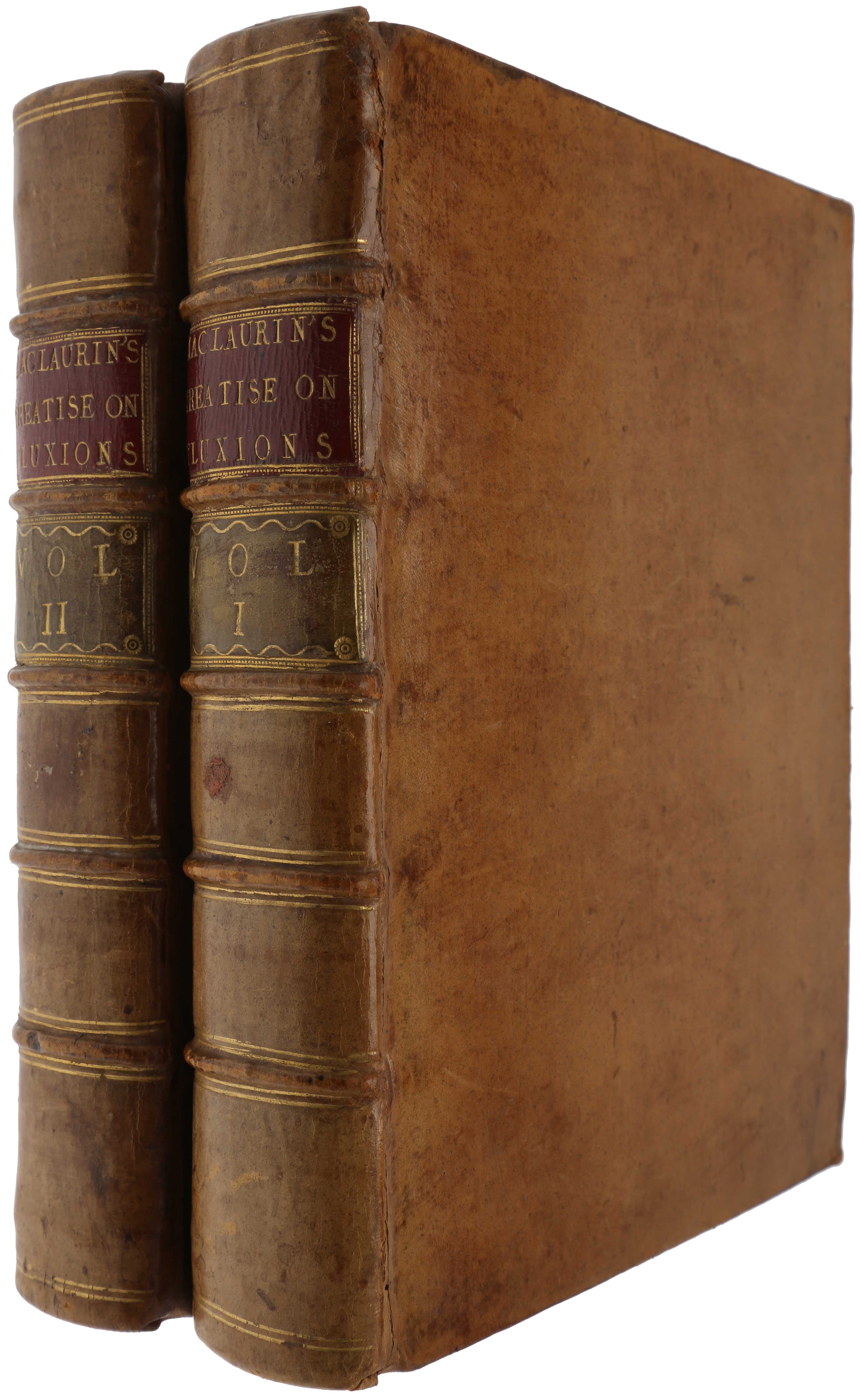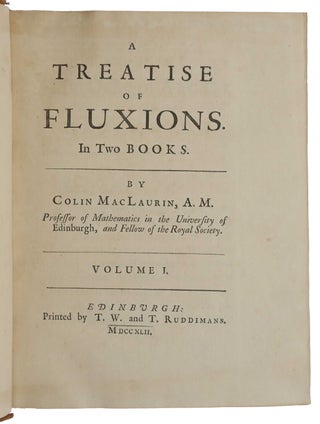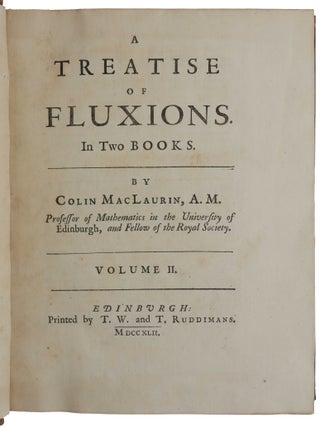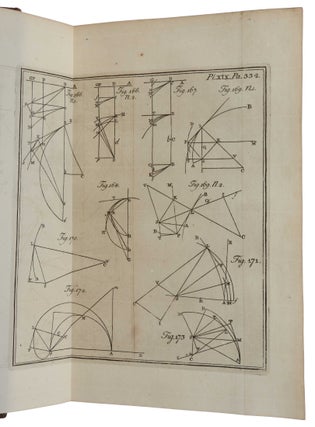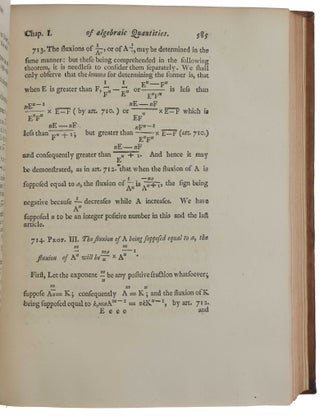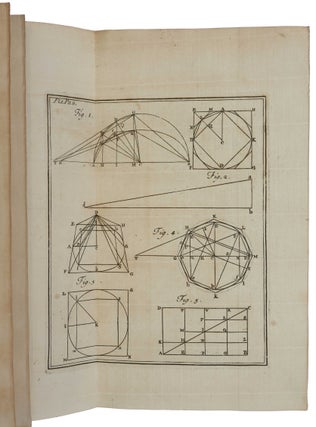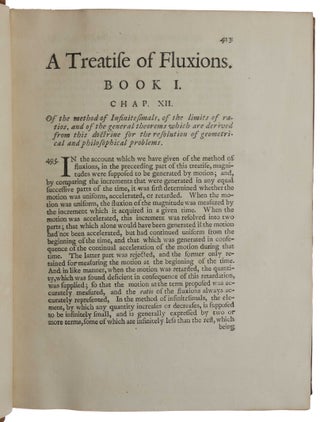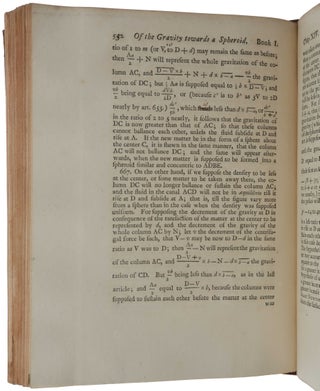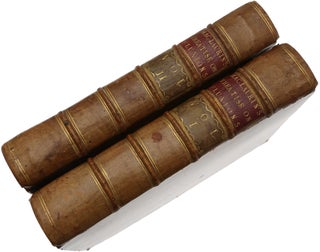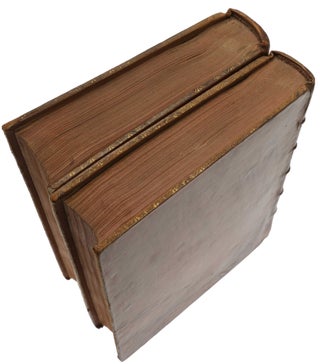A Treatise of Fluxions. In Two Books.
Edinburgh: Printed by T.W. and T. Ruddimans, 1742.
First edition, a very fine large and thick paper copy, of “the earliest logical and systematic publication of the Newtonian methods. It stood as a model of rigor until the appearance of Cauchy’s Cours d’Analyse in 1821” (DSB). The Treatise was written partly (but only partly, see below) as a response to the attack on the foundations of the method of fluxions and infinitesimal calculus made by George Berkeley in The Analyst (1734). “[Berkeley] showed that many definitions in the infinitesimal calculus are paradoxical and cannot be justified by intuition. He explained the success of the new calculus by a repeated neglect of infinitely small quantities leading through a compensation of errors to a correct answer” (Jahnke, A History of Analysis, 127). “MacLaurin provided a rigorous foundation for the method of fluxions based on a limit concept drawn from Archimedean classical geometry. He went on to demonstrate that the method so founded would support the entire received structure of fluxions and the calculus, and to make advances that were taken up by continental analysts … The Treatise was generally cited by British fluxionists as the definitive answer to Berkeley’s criticism, but Maclaurin had accomplished much more than this. Judith Grabiner [see below] has described Maclaurin’s influence on the Continental analysts in detail. Maclaurin’s work was cited with admiration by Lagrange, Euler, Clairaut, d’Alembert, Laplace, Legendre, Lacroix, and Gauss. The influence of Maclaurin’s use of the algebra of inequalities as a basis for his limit arguments can be seen in d’Alembert, L’Huilier, Lacroix and Cauchy. Maclaurin corresponded at length with Clairaut about the attraction of ellipsoids, and the latter in his La figure de la terre (1743) acknowledges his debt; Maclaurin’s influence on this subject can be seen also in d’Alembert, Laplace, Lagrange, Legendre, and Gauss … In addition, Maclaurin’s use of infinite series in the analysis of functions, especially with the Euler–Maclaurin formula, was known to Euler, Lagrange, and Jacobi; while his reduction of fluents to elliptic or hyperbolic curve length was used by d’Alembert and extended by Euler, and Euler influenced Legendre’s work on elliptic integrals” (Landmark Writings in Western Mathematics, pp. 143 & 157). The text block of this copy is about 50% thicker than that of an unpressed (and uncut) copy we handled recently. We know of only one other thick paper copy having appeared on the market, a presentation copy to the Earl of Morton (Sotheby’s 1993).
“The calculus was invented independently by Newton and Leibniz in the late seventeenth century. Newton and Leibniz developed general concepts — differential and integral for Leibniz, fluxion and fluent for Newton — and devised notation that made it easy to use these concepts. Also, they found and proved what we now call the Fundamental Theorem of Calculus, which related the two main concepts. Last, but not least, they successfully applied their ideas and techniques to a wide range of important problems. It was not until the nineteenth century, however, that the basic concepts were given a rigorous foundation.
“In 1734 George Berkeley, later Bishop of Cloyne, attacked the logical validity of the calculus as part of his general assault on Newtonianism. Berkeley’s criticisms of the rigor of the calculus were witty, unkind, and — with respect to the mathematical practices he was criticizing — essentially correct. Maclaurin’s Treatise was supposedly intended to refute Berkeley by showing that Newton’s calculus was rigorous because it could be reduced to the methods of Greek geometry. Maclaurin
himself said in his preface that he began the book to answer Berkeley’s attack, [p. i] and also to rebut Berkeley’s accusation that mathematicians were hostile to religion.
“The majority of Maclaurin’s treatise is contained in its first Book, which is called “The Elements of the Method of Fluxions, demonstrated after the Manner of the Ancient Geometricians” … While Book I is largely, though not entirely, geometric, Book II has a different agenda. Its title is “On the Computations in the Method of Fluxions” [my italics]. Maclaurin began Book II by championing the power of symbolic notation in mathematics [pp. 575-6]. He explained, as I.eibniz before him and Lagrange after him would agree, that the usefulness of symbolic notation arises from its generality. So, Maclaurin continued, it is important to demonstrate the rules of fluxions once again this time from a more algebraic point of view. Maclaurin’s appreciation of the algorithmic power of algebraic and calculus notation expresses a common eighteenth-century theme, one developed further by Euler and Lagrange in their pursuit of pure analysis detached from any kind of geometric intuition. To be sure, Maclaurin, unlikc Euler and Lagrange, did not wish to detach the calculus from geometry. Nonetheless, Maclaurin’s second Book in fact, as well as in rhetoric, has an algorithmic character, and most of its results may be read independently of their geometric underpinnings, even if Maclaurin did not so intend. (In his Preface to Book I, he even urged readers to look at Book II before the harder parts of Book I) [p. iii]. The Treatise of Fluxions, then, was not foreign to the Continental point of view, and may have been written in part with a Continental audience in mind …
“[Maclaurin] had a Continental acquaintance through travel and correspondence. Even before the Treatise of Fluxions, his reputation had been enhanced by his Académie prizes and by his books on geometry. He was thus a respected member of an international network of mathematicians with interests in a wide range of subjects, and the publication of the Treatise of Fluxions was eagerly anticipated on the Continent.
“The Treatise of Fluxions of 1742 was Maclaurin’s major work on analysis, incorporating and somewhat dwarfing what he had done earlier. It contains an exposition of the calculus, with old results explained and many new results introduced and proved. Maclaurin seems to have included almost everything he had done in analysis and its applications to Newtonian physics. In particular, the findings of his Paris prize paper on the tides were included and expanded …
“Let us turn now to some specific evidence for the Continental reputation of Maclaurin’s major work. In I741, Euler wrote to Clairaut that, though he h«d not yet seen the Paris prize papers on the tides, “from Mr. Maclaurin I expect only excellent ideas.” Euler added that he had heard from England (presumably from his correspondent James Stirling) that Maclaurin was bringing out a book on “differential calculus,” and asked Clairaut to keep him posted about this. In turn, Clairaut asked Maclaurin later in 1741 about his plans for the book, which Clairaut wanted to sec before publishing his own work on the shape of the earth. Euler did get the Treatise of Fluxions and read enough of it quickly to praise it in a letter to Goldbach in 1743. Jean d’Alembert, in his Traité de Dynamique of 1743, praised the rigor brought to calculus by the Treatise of Fluxions. D’Alembert’s most recent biographer, Thomas Hankins, argues that Maclaurin’s Treatise, appearing at this time, helped persuade D’Alembert that gravity could best be described as a continuous acceleration rather than a series of infinitesimal leaps. D’Alembert’s general approach to the foundations of the calculus in terms of limits clearly was influenced by Newton’s and Maclaurin’s championing of limits over infinitesimals, in particular by Maclaurin’s clear description of limits in one of the parts of his Treatise of Fluxions that explicitly responds to Berkeley’s objections (and which incidentally may be the first explicit description of the tangent as the limit of secant lines). Lagrange in his Analytical Mechanics said that Maclaurin, in the Treatise of Fluxions, was the first to treat Newton's laws of motion in the language of the calculus in a coordinate system fixed in space …
“Two methods were central to the study of real-variable calculus in the eighteenth and nineteenth centuries. One of these was studying real-valued functions by means of power-series representations. This tradition is normally thought first to flower with Euler; it is then most closely associated with Lagrange, and, later for complex variables, with Weierstrass. The second such method is that of basing the foundations of the calculus on the algebra of inequalities what we now call delta-epsilon proof techniques — and using algebraic inequalities to prove the major results of the calculus; this tradition is most closely associated with the work of Cauchy in the 1820s. I have traced these traditions back to Lagrange and Euler in my work on the origins of Cauchy’s calculus. It is surprising, at least if one accepts the standard picture of the history of the calculus, that both of these methods — studying functions by power series, and basing foundations on inequalities — were materially advanced by Maclaurin in the Treatise of Fluxions … Inequality-based arguments in the calculus as used by Lagrange and Cauchy owe a lot to the eighteenth-century study of algebraic approximations, and it once seemed to me that this was their origin. But the algebra of inequalities as used in Continental analysis, especially in d’Alembert’s pioneering treatment of the tangent as the limit of secants in the article “Différentiel” in the Encyclopädie, must owe something also to Maclaurin’s translation of Archimedean geometry into algebraic dress to justify results in calculus. Throughout the eighteenth century, practitioners of the limit tradition on the Continent use inequalities; a clear line of influence connects Maclaurin’s admirer d’Alembert, Simon L’Huilier (who was a foreign member of the Royal Society), the textbook treatment of limits by Lacroix, and, finally, Cauchy.
“Now let us turn to some of Maclaurin’s work on series. There is, of course, the Maclaurin series, that is, the Taylor series expanded around zero. This result Maclaurin himself credited to Taylor, and it was known earlier to Newton and [James] Gregory. It was called the Maclaurin series by John F. W. Herschel, Charles Babbage, and George Peacock in 1816 and by Cauchy in 1823. Since it was obvious that Maclaurin had not invented it, the attribution shows appreciation by these later mathematicians for the way Maclaurin used the series to study functions. A key application is Maclaurin’s characterization of maxima, minima, and points of inflection of an infinitely differentiable function by means of its successive derivatives. When the first derivative at a point is zero, there is a maximum if the second derivative is negative there, a minimum if it is positive. If the second derivative is also zero, one looks at higher derivatives to tell whether the point is a maximum, minimum, or point of inflection. These results can be proved by looking at the Taylor series of the function near the point in question, and arguing on the basis of the inequalities expressed in the definition of maximum and minimum … his technique is explicitly worked out in Maclaurin's Treatise of Fluxions. Indeed, it appears twice: once in geometric dress in Book I, Chapter IX, and then more algebraically in Book II [pp. 694-6] … Lagrange, in unpublished lectures on the calculus from Turin in the 1750s, after giving a very elementary treatment of maxima and minima, referred to volume II of Maclaurin's Treatise of Fluxions as the chief source for more information on the subject …
“We now turn to work in applied mathematics that constitutes one of Maclaurin’s great claims to fame: the gravitational attraction of ellipsoids and the related problem of the shape of the earth. Maclaurin is still often regarded as the creator of the subject of attraction of ellipsoids. In the eighteenth century, the topic attracted serious work from d’Alembert, Clairaut, Euler, Laplace, Lagrange, Legendre, Poisson, and Gauss. In the twentieth century, Subramanyan Chandrasekhar (later Nobel laureate in physics) devoted an entire chapter of his classic Ellipsoidal Figures of Equilibrium to the study of Maclaurin spheroids (figures that arise when homogeneous bodies rotate with uniform angular velocity), the conditions of stability of these spheroids and their harmonic modes of oscillation, and their status as limiting cases of more general figures of equilibrium. Such spheroids are part of the modern study of classical dynamics in the work of scientists like Chandrasekhar, Laurence Rossner, Carl Rosenkilde, and Norman Lebovitz. Already in 1740 Maclaurin had given a “rigorously exact, geometrical theory” of homogeneous ellipsoids subject to inverse-square gravitational forces, and had shown that an oblate spheroid is a possible figure of equilibrium under Newtonian mutual gravitation, a result with obvious relevance for the shape of the earth.
“Of particular importance was Maclaurin’s decisive influence on Clairaut. Maclaurin and Clairaut corresponded extensively, and Clairaut’s seminal 1743 book La Figure de la Terre frequently, explicitly, and substantively cites his debts to Maclaurin’s work. A key result, that the attractions of two confocal ellipsoids at a point external to both are proportional to their masses and are in the same direction, was attributed to Maclaurin by d’Alemhert, an attribution repeated by Laplace, Lagrange, and Legendre, then by Gauss … Lagrange began his own memoir on the attraction of ellipsoids by praising Maclaurin’s treatment in the prize paper of 1740 as a masterwork of geometry, comparing the beauty and ingenuity of Maclaurin’s work with that of Archimedes … Maclaurin’s work on the attraction of ellipsoids shows how his geometric insights fruitfully influenced a subject that later became an analytic one.
“The Euler-Maclaurin formula expresses the value of definite integrals by means of infinite series whose coefficients involve what are now called the Bernoulli numbers. The formula shows how to use integrals to find the partial sums of series … James Stirling in 1738, congratulating Euler on his publication of that formula, told Euler that Maclaurin had already made it public in the first part of the Treatise of Fluxions, which was printed and circulating in Great Britain in 1737. (On this early publication, see also pp. iii, 691n) … Euler and Maclaurin derived the Euler-Maclaurin formula in essentially the same way, from a similar geometric diagram and then by integrating various Taylor series and performing appropriate substitutions to find the coefficients. Maclaurin’s approach is no more Archimedean or geometric than Euler’s; they are similar and independent [pp. 289-93 & 672-5]. In subsequent work, Euler went on to extend and apply the formula further to many other series, especially in his Introductio in analysin infinitorum of 1748 and Institutiones calculi differentialis of 1755. But Maclaurin, like Euler, had applied the formula to solve many problems. [pp. 676-93]. For instance, Maclaurin used it to sum powers of arithmetic progressions and to derive Stirling’s formula for factorials. He also derived what is now called the Newton-Cotes numerical integration formula, and obtained what is now called Simpson’s rule as a special case. It is possible that his work helped stimulate Euler’s later, fuller investigations of these important ideas … Jacobi, who called the result simply the Maclaurin summation formula, cited it directly from the Treatise of Fluxions. Later, Karl Pearson used the formula as an important tool in his statistical work, especially in analyzing frequency curves. The Euler-Maclaurin formula, then, is an important result in the mainstream of mathematics, with many applications, for which Maclaurin, both in the eighteenth century and later on, has rightly shared the credit.
“Some integrals (Maclaurin used the Newtonian term “fluents”) are algebraic functions, Maclaurin observed. Others are not, but some of these can be reduced to finding circular arcs, others to finding logarithms. By analogy, Maclaurin suggested, perhaps a large class of integrals could be studied by being reduced to finding the length of an elliptical or hyperbolic arc [p. 652]. By means of clever geometric transformations, Maclaurin was able to reduce the integral that represented the length of a hyperbolic arc to a ‘nice’ form. Then, by algebraic manipulation, he could reduce some previously intractable integrals to that same form. His work was translated into analysis by d’Alembert and then generalized by Euler. In 1764, Euler found a much more elegant, general, and analytic version of this approach, and worked out many more examples, but cited the work of Maclaurin and D’Alembert as the source of his investigation. A.-M. Legendre, the key figure in the eighteenth-century history of elliptic integrals, credited Euler with seeing that, by the aid of a good notation, arcs of ellipses and other transcendental curves could be as generally used in integration as circular and logarithmic arcs … Thus, although his successors accomplished more, Maclaurin helped initiate a very important investigation and was the first to appreciate its generality. Maclaurin’s geometric insight, applied to a problem in analysis, again brought him to a discovery …
“The Treatise of Fluxions was not really intended as a reply to Berkeley. Maclaurin could have refuted Berkeley with a pamphlet. It was not a student handbook either; this work is far from elementary. Nor was it merely written to glory in Greek geometry. Maclaurin wrote several works on geometry per se. But he was no antiquarian. Instead, the Treatise of Fluxions was the major outlet for Maclaurin’s solution of significant research problems in the field we now call analysis. Geometry, as the examples I gave illustrate, was for Maclaurin a source of motivation, of insight, and of problem-solving power, as well as being his model of rigor.
“For Maclaurin, rigor was not an end in itself, or a goal pursued for purely philosophical reasons. It was motivated by his research goals in analysis. For instance, Maclaurin developed his theory of maxima, minima, points of inflection, convexity and concavity, orders of contact, etc., because he wanted to study curves of all types, including those that cross over themselves, loop around and are tangent to themselves, and so on. He needed a sophisticated theory to characterize the special points of such curves. Again, in problems as different as studying the attraction of ellipsoids and evaluating integrals approximately, he needed to use infinite series and know how close he was to their sum. Thus, rigor, to Maclaurin, was not merely a tool to defend Newton's calculus against Berkeley — though it was that — nor just a response to the needs of a professor to present his students a finished subject — though it may have been that as well. In many examples, Maclaurin's rigor serves the needs of his research.
“Moreover, the Treatise of Fluxions contains a wealth of applications of fluxions, from standard physical problems such as curves of quickest descent to mathematical problems like the summation of power series — in the context of which, incidentally. Maclaurin gave what may be the earliest clear definition of the sum of an infinite series: “There are progressions of fractions which may be continued at pleasure, and yet the sum of the terms be always less than a certain finite number. If the difference betwixt their sum and this number decrease in such a manner, that by continuing the progression it may become less than any fraction how small soever that can be assigned, this number is the limit of the sum of the progression, and is what is understood by the value of the progression when it is supposed to be continued indefinitely [p. 289].” Thus, though eighteenth-century Continental mathematicians did not care passionately about foundations, they could still appreciate the Treatise of Fluxions because they could mine it for results and techniques” (Grabiner).
A child prodigy, Colin Maclaurin (1698-1746) entered the University of Glasgow aged 11. At the age of 19 he was elected a professor of mathematics at Marischal College, Aberdeen, and two years later he became a fellow of the Royal Society of London, and there became acquainted with Newton. On the recommendation of Newton, he was made a professor of mathematics at the University of Edinburgh in 1725. In 1740 he shared, with Leonhard Euler and Daniel Bernoulli, the prize offered by the French Academy of Sciences for an essay on tides.
Norman 1408; Honeyman 2084. J.V. Grabiner, Was Newton's calculus a dead end? The continental influence of Maclaurin's treatise of fluxions, American Mathematical Monthly 104 (1997), 393-410.
4to (228 x 178 mm), pp [6], [i] ii-vi, 1-412 and 25 engraved folding plates; [2], 413-763 [1:errata] and 16 engraved plates (complete). Bound in two fine English polished calf with red and green gilt spine labels, five raised bands. Upper joints with small cracks, corners with light wear. A very fine and unrestored copy.
Item #4222
Price: $15,000.00

